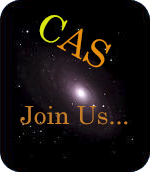Klaus Photo Gallery - Chile 2009 1 of 2
Gallery 1 || Gallery 2 ||
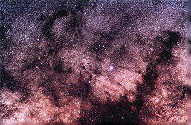
Dark Nebulae 135 mm |
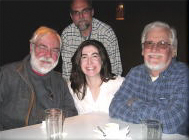
Dinner in San Pedro |
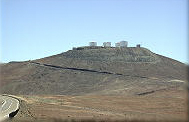
ESO |
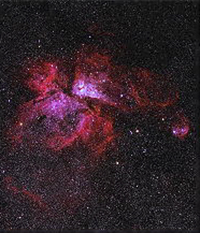
Carina Nebula Tak |
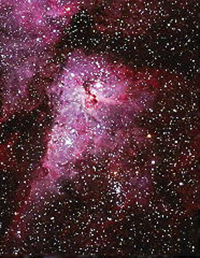
Keyhole Nebula |
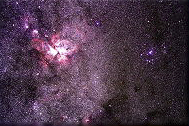
Carina Region |
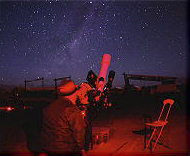
Star Party |
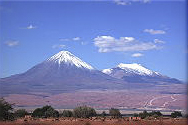
Licancabur Volcano |
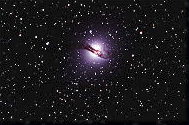
Centaurus A |
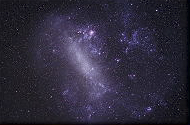
LMC 135 mm f2 |
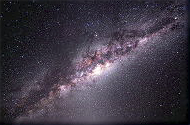
Milky Way 10 mm f6 |
An Astronomical Odyssey to Chile
By Klaus Brasch
Can you imagine spending 12 days and nights observing under pristine and cloud-free skies, surrounded by stunning scenery, unique artistic, gastronomic and cultural delights and extremely friendly people? Died and gone to heaven? Well maybe not, but at an elevation near 8,000 feet (2,440 meters) above sea level on the Atacama plateau in northern Chile; you are definitely a step closer. There are many reasons why several major world observatories are located in the Atacama Desert. It is the driest locality on Earth, with practically no measurable precipitation and almost year-round clear skies. Couple that with exceptional transparency, virtually no light pollution, very good average seeing conditions and the incomparable southern skies, and you are indeed in astronomy heaven.
I had the good fortune of joining a dozen dedicated Canadian amateur astronomers in 2009 at the Atacama Lodge near the delightful town of San Pedro de Atacama. Operated by astronomer Alain Maury and partners, the lodge caters to amateur astronomers from all over the world, providing accommodations, star tours, telescopes and sightseeing excursions to nearby natural wonders and to astronomical facilities like the European Southern Observatory (ESO), the largest optical observatory in the world, and the soon to be completed ALMA facility. For complete information see: www.spaceobs.com/en/lodge.php
Although some of our fellow travelers brought complete telescopes, mounts, CCD cameras, computers and other accessories, my friend Terry Dickinson and I opted to keep things light. Between us we had several Canon DSLRs, a wide assortment of lenses and filters, and a small equatorial mount suitable for piggy back style shooting. In addition we rented time on a permanently mounted Takahashi FS-102 apochromatic refractor and a C-14 with Hyper Star available on site. This proved so successful that we secured some 300 individual astro imaage for later processing.
The physical setting of the region is simply stunning. Surrounded by some of the highest, snowcapped volcanoes in the world, some of them active, the Atacama plateau lies against the Andean cordillera, extending from about 8,000 feet to over 16,000 feet in elevation. That is where the Atacama Large Millimeter Array (ALMA) is located, an imposing international facility funded by the US National Radio Astronomy Observatory (NRAO) and several other countries. Though extremely dry, the Atacama region contains a number of fresh water lagoons, fed by underground glaciers. Spectacular Laguna Chaxa, part of Chile’s Reserva Nacional los Flamencos, is home to hundreds of species of birds, reptiles and crustaceans. Even more impressive is nearby Valle de la Luna (Valley of the Moon). Aptly named, this geologic wonderland has vistas reminiscent of the Moon and Mars and has been used to test Mars rover prototypes. So, if you enjoy astronomy, culture, hiking, mountaineering, wild life, geology or archeology, this place has it all.
Ultimately, however, the unparalleled beauty of the southern Milky Way and the Magellanic Clouds are what captivates us the most. Apart from incredible show pieces like the Carina Nebula, Omega Centauri, the Coal Sack, 47 Tucanae and countless other objects, the full span of our galaxy bridging the firmament overwhelms visitors from the northern hemisphere. Under the jet black Chilean skies, the Milky Way actually casts a shadow when fully overhead and vividly demonstrates that we reside in one arm of an enormous spiral galaxy. Likewise, viewing and imaging the Large Magellanic Cloud (LMC) gives the feeling that you are traveling in space.
In addition to astrophotography, we also spent time observing deep sky objects with many of the telescopes at the lodge. The Carina nebula, brighter than our beloved Orion nebula and roughly four times its angular size, actually revealed distinct pink coloration through a 22-inch Dobsonian. Mega clusters, Omega Centauri and 47 Tucanae were dazzling, and the Tarantula Nebula in the LMC showed extensive structure and detail. One of our fellow travelers, a dedicated planetary nebula aficionado, identified some 20 in the LMC alone. Other favorite objects, including the Sagittarius array of M8, 16, 17, 20 and 22, appeared far brighter and more imposing because they are straight overhead there rather than low on the horizon as in our northern latitudes.
All our astro imaging was done with Hutech modified Canon DSLRs coupled with selective IDAS filters. We had wide angle lenses, medium and long telephotos, as well as use of on-site telescopes. Exposures typically ran from a few to several minutes at ISO 800-1600, with multiple images for stacking and processing.
For full details see my article: Chilean Imaging Odyssey, Sky & Telescope, October 2011, pg. 72
Outreach || Flagstaff || Photos || Articles || Observing Sites || Weather
Coordinated Universal Time || National Weather Service
info@coconinoastro.org

